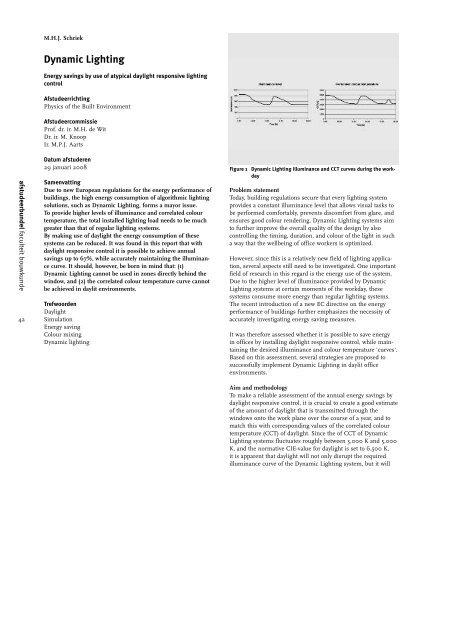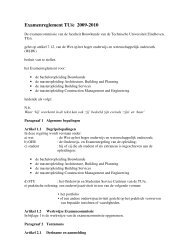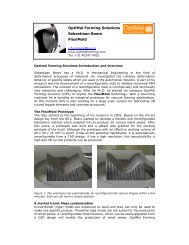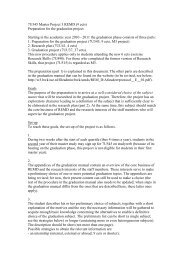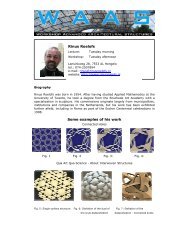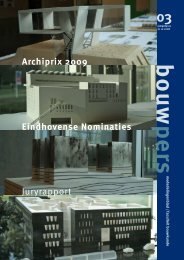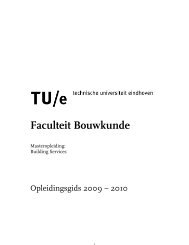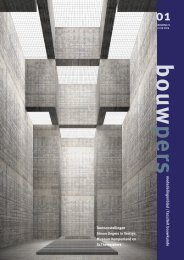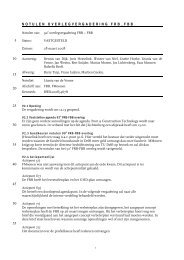afst.bundel 8 MEI 07 - Technische Universiteit Eindhoven
afst.bundel 8 MEI 07 - Technische Universiteit Eindhoven
afst.bundel 8 MEI 07 - Technische Universiteit Eindhoven
Create successful ePaper yourself
Turn your PDF publications into a flip-book with our unique Google optimized e-Paper software.
M.H.J. Schriek<br />
Dynamic Lighting<br />
Energy savings by use of atypical daylight responsive lighting<br />
control<br />
Afstudeerrichting<br />
Physics of the Built Environment<br />
Afstudeercommissie<br />
Prof. dr. ir. M.H. de Wit<br />
Dr. ir. M. Knoop<br />
Ir. M.P.J. Aarts<br />
<strong>afst</strong>udeer<strong>bundel</strong> faculteit bouwkunde<br />
42<br />
Datum <strong>afst</strong>uderen<br />
29 januari 2008<br />
Samenvatting<br />
Due to new European regulations for the energy performance of<br />
buildings, the high energy consumption of algorithmic lighting<br />
solutions, such as Dynamic Lighting, forms a mayor issue.<br />
To provide higher levels of illuminance and correlated colour<br />
temperature, the total installed lighting load needs to be much<br />
greater than that of regular lighting systems.<br />
By making use of daylight the energy consumption of these<br />
systems can be reduced. It was found in this report that with<br />
daylight responsive control it is possible to achieve annual<br />
savings up to 67%, while accurately maintaining the illuminance<br />
curve. It should, however, be born in mind that: (1)<br />
Dynamic Lighting cannot be used in zones directly behind the<br />
window, and (2) the correlated colour temperature curve cannot<br />
be achieved in daylit environments.<br />
Trefwoorden<br />
Daylight<br />
Simulation<br />
Energy saving<br />
Colour mixing<br />
Dynamic lighting<br />
Figure 1<br />
Dynamic Lighting illuminance and CCT curves during the workday<br />
Problem statement<br />
Today, building regulations secure that every lighting system<br />
provides a constant illuminance level that allows visual tasks to<br />
be performed comfortably, prevents discomfort from glare, and<br />
ensures good colour rendering. Dynamic Lighting systems aim<br />
to further improve the overall quality of the design by also<br />
controlling the timing, duration, and colour of the light in such<br />
a way that the wellbeing of office workers is optimized.<br />
However, since this is a relatively new field of lighting application,<br />
several aspects still need to be investigated. One important<br />
field of research in this regard is the energy use of the system.<br />
Due to the higher level of illuminance provided by Dynamic<br />
Lighting systems at certain moments of the workday, these<br />
systems consume more energy than regular lighting systems.<br />
The recent introduction of a new EC directive on the energy<br />
performance of buildings further emphasizes the necessity of<br />
accurately investigating energy saving measures.<br />
It was therefore assessed whether it is possible to save energy<br />
in offices by installing daylight responsive control, while maintaining<br />
the desired illuminance and colour temperature 'curves'.<br />
Based on this assessment, several strategies are proposed to<br />
successfully implement Dynamic Lighting in daylit office<br />
environments.<br />
Aim and methodology<br />
To make a reliable assessment of the annual energy savings by<br />
daylight responsive control, it is crucial to create a good estimate<br />
of the amount of daylight that is transmitted through the<br />
windows onto the work plane over the course of a year, and to<br />
match this with corresponding values of the correlated colour<br />
temperature (CCT) of daylight. Since the of CCT of Dynamic<br />
Lighting systems fluctuates roughly between 3,000 K and 5,000<br />
K, and the normative CIE-value for daylight is set to 6,500 K,<br />
it is apparent that daylight will not only disrupt the required<br />
illuminance curve of the Dynamic Lighting system, but it will


